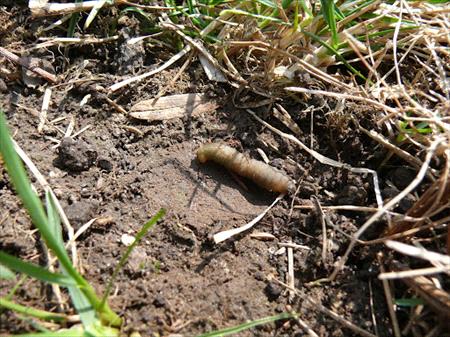Your Cart

Learn Your Lawn: Leatherjackets (Crane Flies)
WHAT ARE LEATHERJACKETS?
Leatherjackets are the larvae of the European Crane Fly. This pest causes damage in coastal areas of North America, Europe, and Australia. Since the mid 1990s, Leatherjackets have been migrating inland, and there has been a significant increase in documented cases of Leatherjackets in non- coastal regions. They are often found in lawns and gardens, where they feed on the roots of grass and other plants.
WHAT IS THE LIFECYCLE OF LEATHERJACKETS?
• Egg Stage: Leatherjacket females lay up to 350 shiny black eggs in the grass and soil, typically near grass roots. The eggs hatch within a couple of weeks.
• Larva Stage: This is the most destructive stage, as Leatherjacket larvae feed on the roots of grass, causing significant damage to lawns. The larvae can grow up to 21⁄2 inches long and can live in the soil for up to two years, causing most damage between March and June, depending on the climate.
• Pupa Stage: After feeding and growing, the larvae will form a pupal case in the soil, where they undergo metamorphosis into the adult form: a Crane Fly. This stage lasts for about two to four weeks.
• Adult Stage (Crane Fly): The Crane Fly is a large, long- legged insect resembling a mosquito. It emerges from the soil in late summer or early fall. The adults do not feed, living only for a few days to mate and lay eggs, starting the cycle all over again.
The lifespan of the leatherjacket can vary greatly depending on climate and environmental factors, but it typically ranges from one to two years.
WHAT CAN BE DONE TO CONTROL LEATHERJACKETS IN MY LAWN?
Leatherjackets are ideally controlled early in their life cycle, before severe damage occurs. Damage may not always be obvious, but it is very common to find Leatherjackets on sidewalks and driveways right after a heavy rainfall. A change in cultural practices can help deter infestations of this pest. However, if damage becomes severe, other forms of control may be necessary.
A thick, healthy, well-maintained lawn is always the best line of defense. This can be achieved through beneficial cultural practices, which include:
• Watering: Deep and infrequent watering is essential for strong plant health and development. A general rule of thumb is to water each area of your lawn for 30-45 minutes, twice per week, in the early morning so the turf is dry by nightfall.
• Mowing: Maintain a regular mowing schedule throughout the growing season. In general, you should keep your lawn between 2 1⁄2 and 3 1⁄2 inches high, but during the hottest weeks of summer, you may allow the grass to grow as high as 4 inches. Never remove more than 1/3 of the grass blade at each mowing.
• Fertilizing: Regular applications of Weed Man’s specially formulated, slow-release granular fertilizer will help provide your lawn with adequate nutrients. These applications are timed specifically to avoid over fertilizing the lawn.
• Core Aeration: Aerating your lawn can improve soil drainage and help reduce the likelihood of insect infestations. It will also alleviate soil compaction and allow water and nutrients to penetrate deeper into the soil.
Your local Weed Man professional may be able to offer other solutions and recommend the best form of treatment that is available to improve the conditions of your lawn.
 English (USA)
English (USA) Français (CANADA)
Français (CANADA)


